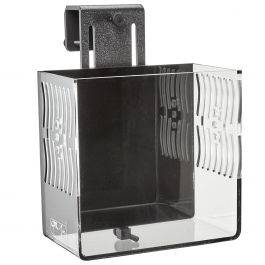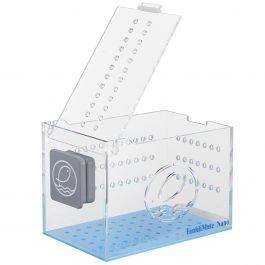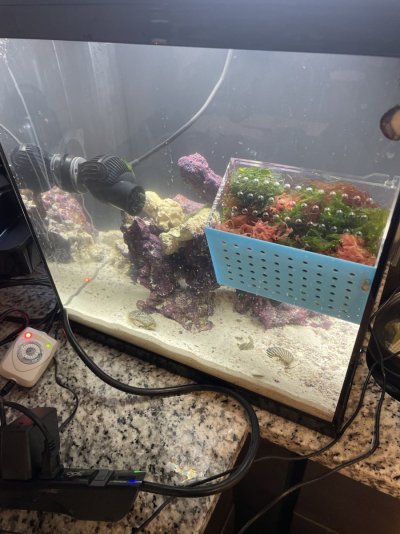I’m dealing with a weird situation where my chaeto, sea lettuce, and pom pom don’t appear to be doing well, but my red ogo is doing great. I have no clue why the green macros (and the Pom Pom) are suffering while the red ogo is thriving, and I’d like to make sure this isn’t indicative of a problem. Moreover, I’d like to reintroduce green macros, but want to make sure I know what went wrong so they don’t die off again.
I don’t mean to rant, but the following text is my attempt at providing as much info as possible to help with diagnosing my problem.
I am a college student and I knew that I was going to be away from my tank over winter break, so in the weeks prior, I thought it prudent to set up a refugium.
my tank is a JBJ cubey 20G, and since it’s got both the heavy plastic light+lid and an especially thick rim, traditional hang on equipment doesn’t work. Since I couldn’t hang a refugium out the side, and I also was afraid that if I got the normal in tank refugium box like this one,

 www.bulkreefsupply.com
www.bulkreefsupply.com
because my tank is lit by a small LED panel located in the middle of the lid, I would either have to locate the box off to the side where it wouldn’t receive light, or if I lowered the box so the light spread to it, the macros could float out and cause problems for my pump and the powerhead I had in there. As a result, I did something a bit atypical, I used an acclimation box.

 www.bulkreefsupply.com
www.bulkreefsupply.com
It provided a lid so that the macros couldn’t float out. I also made sure to tilt the box so that two panes were receiving light, and also, so that the slight gap between the lid and side pane allowed air bubbles formed by the photosynthesis to climb up the surface and eventually escape instead of being trapped under a level surface. I also had the powerhead pointing in the general direction, so that the macros were receiving a good bit of flow.

I used the Algae barn macro starter kit, so I had 2oz each of chaeto, sea lettuce, Pom Pom, and red ogo.
this is what my tank looked like while I was away. The white and red lights were on for 12 hours a day, the blue channel was on for 10 hours and 45 minutes every day, and the powerhead was on for one hour burst, with one hour rest periods during the day, and the rest periods stretched to multiple hours during the night. I’ll provide the schedules if that matters.
when I got back, the tank was still healthy (yay!) my main inhabitant, a box crab I found in the wild myself, had not only survived but molted and doubled in size. My water parameters, when tested, were actually better than they had been prior to my departure- which makes sense considering this tank was only about a month and a half old at time time. My nitrite finally zero’s and while my nitrate is higher than recommended values, it’s clearly decreasing.
what caught me off guard, however, was the state of my algae, both macro and undesired. I had a fair bit of brown slime/sludge on the acclimation box- during my water change the day after I returned, I had to scrub the heck out of it with a toothbrush. Moreover- I still had a decent bit of nuissance algae growth. I’m not exactly sure what kind- it has the green coloration and growth locations of hair algae, but does not actually have the long tufts associated with it. Which means my refugium did not fully beat out the other algaes for the excess phosphate and nitrate.
However, the most notable thing, as mentioned initially, was the decline of my green macros. My chaeto seems to have simply vanished, I’m not seeing Pom pom left (some dead bleached chunks), and my green sea lettuce, while some small leaves survived, many were missing. After cleaning amidst the water change, in the current state, my fuge box is predominantly red ogo.
So… what went wrong? Was the box too high in the water column and I bleached the chaeto? I’ve since reaquascaped and I left room in the rear corner to have the fuge box against the sandbed. I also mixed the macros together into a ball, so maybe the chaeto and Pom Pom were too heavily shaded by the red ogo and therefore outcompeted? Or, does macro in close proximity attack each other the way coral does?
I don’t mean to rant, but the following text is my attempt at providing as much info as possible to help with diagnosing my problem.
I am a college student and I knew that I was going to be away from my tank over winter break, so in the weeks prior, I thought it prudent to set up a refugium.
my tank is a JBJ cubey 20G, and since it’s got both the heavy plastic light+lid and an especially thick rim, traditional hang on equipment doesn’t work. Since I couldn’t hang a refugium out the side, and I also was afraid that if I got the normal in tank refugium box like this one,

Small CITR3 Pro DX In-Tank Refugium
The CITR3 Pro’s versatility and ease of use make it a valuable addition to any aquarium. You can use the CITR3 as a refugium to improve filtration by growing and harvesting macroalgae, as a designated space for cultivating small organisms like copepods and amphipods as food, or even as an...
because my tank is lit by a small LED panel located in the middle of the lid, I would either have to locate the box off to the side where it wouldn’t receive light, or if I lowered the box so the light spread to it, the macros could float out and cause problems for my pump and the powerhead I had in there. As a result, I did something a bit atypical, I used an acclimation box.

Tanklimate Acclimation Box - Nano
Introduce and Isolate Fish, Corals or Invertebrates There are many different uses for the Eshopps Tanklimate, and most notably acclimating and introducing new fish to an already established aquarium, which can help reduce the stress on your new fish. TankliMate Nano incorporates small 4mm square...
It provided a lid so that the macros couldn’t float out. I also made sure to tilt the box so that two panes were receiving light, and also, so that the slight gap between the lid and side pane allowed air bubbles formed by the photosynthesis to climb up the surface and eventually escape instead of being trapped under a level surface. I also had the powerhead pointing in the general direction, so that the macros were receiving a good bit of flow.

I used the Algae barn macro starter kit, so I had 2oz each of chaeto, sea lettuce, Pom Pom, and red ogo.
this is what my tank looked like while I was away. The white and red lights were on for 12 hours a day, the blue channel was on for 10 hours and 45 minutes every day, and the powerhead was on for one hour burst, with one hour rest periods during the day, and the rest periods stretched to multiple hours during the night. I’ll provide the schedules if that matters.
when I got back, the tank was still healthy (yay!) my main inhabitant, a box crab I found in the wild myself, had not only survived but molted and doubled in size. My water parameters, when tested, were actually better than they had been prior to my departure- which makes sense considering this tank was only about a month and a half old at time time. My nitrite finally zero’s and while my nitrate is higher than recommended values, it’s clearly decreasing.
what caught me off guard, however, was the state of my algae, both macro and undesired. I had a fair bit of brown slime/sludge on the acclimation box- during my water change the day after I returned, I had to scrub the heck out of it with a toothbrush. Moreover- I still had a decent bit of nuissance algae growth. I’m not exactly sure what kind- it has the green coloration and growth locations of hair algae, but does not actually have the long tufts associated with it. Which means my refugium did not fully beat out the other algaes for the excess phosphate and nitrate.
However, the most notable thing, as mentioned initially, was the decline of my green macros. My chaeto seems to have simply vanished, I’m not seeing Pom pom left (some dead bleached chunks), and my green sea lettuce, while some small leaves survived, many were missing. After cleaning amidst the water change, in the current state, my fuge box is predominantly red ogo.
So… what went wrong? Was the box too high in the water column and I bleached the chaeto? I’ve since reaquascaped and I left room in the rear corner to have the fuge box against the sandbed. I also mixed the macros together into a ball, so maybe the chaeto and Pom Pom were too heavily shaded by the red ogo and therefore outcompeted? Or, does macro in close proximity attack each other the way coral does?















